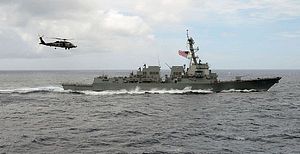It has been abundantly obvious in recent weeks that ties between the United States and China are heading for a sharp decline.
The collapse is occurring on multiple tracks.
Following the escalation of the U.S.-China trade war with the Trump administration’s decision to move ahead on a U.S.$200 billion round of additional tariffs, Beijing saw it fit to call off scheduled talks.
The security and military-to-military component of relations also has seen hits along multiple fronts. In September, the U.S. Treasury Department moved forward with sanctions on the People’s Liberation Army’s Equipment Development Department after China took delivery of Russia’s advanced S-400 surface-to-air missile system and Su-35S multirole fighters.
Beijing responded by first cancelling scheduled military-to-military talks. Subsequently, a higher-level annual Diplomatic and Security Dialogue scheduled for this month was also called off.
At the same time, ill-feeling spiked in the South China Sea, long a hotbed for Sino-American tensions.
The U.S.S Decatur, a U.S. Navy guided missile destroyer, was challenged aggressively by the Lanzhou, a People’s Liberation Army Navy Type 052C destroyer, near Gaven Reef.
The Lanzhou manoeuvred aggressively toward the U.S. warship, disregarding basic international navigation rules designed to avoid at-sea collisions.
The incident easily could have pushed tensions to a breaking point, had a collision occurred.
While the U.S. Department of Defence has said the vessels came within 45 yards of each other, released images appear to show they were even closer to each other than initially stated.
The incident seems particularly ironic, given Chinese state media’s criticism of the U.S. Navy last year for posing a navigational hazard in Asia’s international waters after separate collisions involving two American warships – the U.S.S John S. McCain and the U.S.S Fitzgerald – killed 17 sailors.
The series of incidents that drove up anxiety, however, shows no sign of stopping.
On Thursday, U.S. Vice-President Mike Pence delivered what is sure to go down as one of the more consequential official high-level U.S. addresses on Washington’s relationship with Beijing.
Speaking at the conservative Hudson Institute, Pence leaned in and took Beijing to task on a range of fronts.
In the U.S., the headlines zeroed in on the vice-president’s explication of President Donald Trump’s offhand comments about China at the UN Security Council in late September and Pence’s charge that China was interfering in the upcoming U.S. midterm elections.
Pence outlined a range of measures that he said China had taken in its effort to influence American democracy and urged American journalists to continue to research the topic.
But even outside the issue of influence, Pence outlined a long list of other grievances. These included China’s treatment of its Uygur minority in the Xinjiang Uygur autonomous region, its predatory debt practices in Asia, media censorship and expansionist ambitions in Asia.
The speech foreshadowed Pence’s trip later this year to Asia, where he will represent the administration at the usual round of regional summitry.
Pence will head to Association of Southeast Asian Nations’ summits, including the East Asia Summit, in Singapore, and the Asia-Pacific Economic Cooperation summit in Papua New Guinea.
The vice-president’s speech put into words the range of issues that vex U.S.-China ties today, but it did not outline how exactly the Trump administration will steer the U.S. to prevail. More seriously, it left undefined the concept of victory itself in the kind of great power competition the vice-president described.
What will it mean for the U.S. to prevail in this competition?
Is the objective to shape the choices made by the Chinese Communist Party leadership, or to more fundamentally pursue victory by subjugating and undermining China’s almost inevitable rise?
That latter objective hasn’t been ruled out by the administration; what is more, it could prove the most dangerous of the two by setting the countries on a path to a more serious confrontation that could lead to direct conflict.
In the domestic political context of the U.S., the vice-president missed an important opportunity to pursue a bipartisan consensus on the nature of the Chinese Communist Party’s attempts to influence American democracy.
Instead of framing any attempt to undermine U.S. democracy as a challenge to the American people, Pence framed the issue in openly partisan terms, saying that China wanted “a different American president”.
Whatever the current political reality in the U.S., the Trump administration will not be around forever. However, the competition that Pence identified is likely to persist beyond this administration, requiring a concerted and potentially decades-long U.S. strategic effort.
For now, that does not appear to be on the cards.
This article first appeared in the South China Morning Post. It is republished here with kind permission.

































